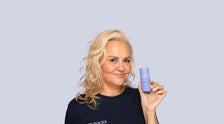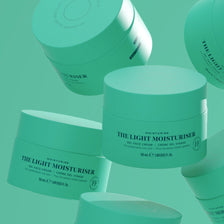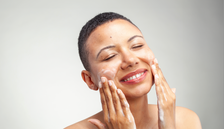THE EXFOLITONE SERIES
You've probably heard a lot about acids in skincare. They sound a bit scary, but also excitingly powerful - what exactly do they do, and do you need to use them? Here's the lowdown on the most common acids in skincare.
What is an acid?
Chemically speaking, an acid is any ingredient that can donate hydrogen ions. The amount of hydrogen ions is measured by pH - a lower pH means greater acidity. Acidic skincare products often have a lower pH than our skin, which is naturally acidic and sits at around pH 5.5, so they can sometimes be irritating. However, not all acids are irritating, so don't get scared off by the word "acid!"
Hydroxy Acids:
Most of the time when people talk about acids in skincare, they're talking about hydroxy acids. These are chemical exfoliants that gently coax dead skin cells into coming off your skin (or not so gently if you use too much - don't do that). Ideally, your skin takes care of this process on its own (a process called desquamation), but lots of factors can affect how well this works: climate, genetics and age, to name a few.
If your skin isn't exfoliating itself effectively, you can end up with dull and rough skin, clogged pores, and it can make your skin look more textured and crepey than it should. Chemical exfoliants like hydroxy acids help this process along. Depending on the acid, hydroxy acids can also have some other benefits too:
Alpha Hydroxy Acids (AHAs)
This is the biggest "family" of acids in skincare. Their main role is chemical exfoliation, but in studies they've also been observed to have other effects on the skin like increasing collagen, reducing fine lines, preventing acne, fading dark spots, and evening out skin tone and texture. They're also humectant moisturisers that help to hydrate your skin.
Usually, you'll find AHAs in watery products (toners, essences, serums) that you leave on your skin to work. Sometimes they'll also show up in cleansers and rinse-off peels. Stronger versions of these products are used in professional treatments.
For all leave-on AHA products, it's important to look at both the percentage and the pH. A higher percentage of the AHA will be more effective, but it's also possible for it be too effective and get rid of too much skin - your skin's main job is to act as a barrier and dead skin cells are an important part of this, so exfoliating too much leads to irritation and redness. If you're just
starting on AHAs, I'd recommend a leave-on product with less than 10% AHA and a pH of around 4.
AHAs have also been found to make skin more sensitive to the sun and this effect can last for over a week after you've stopped using it, so you can't get around this by using it at night. To reduce the chances of sun damage, make sure you're wearing a sunscreen during the day (preferably over SPF 30) when using AHA products.
Glycolic Acid
The smallest and most commonly found of the AHAs. Because it's been around for so long, it also has the most studies to back up its effectiveness. It's small, so it gets into skin more easily and tends to be more effective and faster at exfoliating… but on the flip side, it can be more irritating. It's the key ingredient in a lot of classic cult products like Pixi Glow Tonic, Alpha-H Liquid Gold and Biologique Recherche P50 Lotion.
Lactic Acid
This is the second smallest AHA and it's getting more popular in skincare. It's a little gentler than glycolic acid due to its larger size, making it less efficient at getting into your skin, but studies have also found that it seems to be more effective at treating sun-damaged skin.
Lactic acid might also be able to increase ceramide levels in skin. Ceramides are important oily substances that help your skin barrier stay intact and resistant.
Mandelic Acid
The molecule size of mandelic acid is quite a bit larger than glycolic and lactic acids, making it less irritating and a good option for sensitive skin.
Beta Hydroxy Acid aka Salicylic Acid
This category only really has one commonly found member in skincare: salicylic acid. Much like alpha hydroxy acids, salicylic acid is used as a chemical exfoliant in skincare products and can be particularly beneficial for oilier skin types. On top of that, it's also anti-inflammatory. Salicylic acid is often found in medicated products for treating acne (it's an OTC drug in many countries), including spot treatments, toners and cleansers. Like with AHAs, it's also used at higher concentrations in professional peel products, and in wart and corn removers.
As a chemical exfoliant it's used at concentrations between 0.5 and 2%. There's evidence that pH isn't important for salicylic acid products, so for less irritation, you can use a higher pH product.
Polyhydroxy Acids
Unlike AHAs and BHA, polyhydroxy acids (PHAs) have multiple hydroxy groups on the one molecule. They're also chemical exfoliants and have many of the same skincare benefits as AHAs, including smoothing and evening out skin tone, increasing skin clarity and brightness, increasing the production of water-holding glycosaminoglycans (GAGs) in the skin, increasing collagen production and skin plumping.
There are a few things that PHAs do better than AHAs though, which is why they're called the "next generation" of acid exfoliants. The multiple hydroxy groups make them better humectant moisturisers than AHAs, and they're a lot gentler on the skin (in studies, they've been used on people with sensitive skin conditions like rosacea and atopic dermatitis). They are also antioxidants that can protect the skin from free radicals (highly reactive, skin-damaging substances that can contribute to premature aging) and aren't associated with increased photosensitivity.
Want to add hydroxy acids to your skincare routine? Check out The Acid Box.
Other Acids:
Retinoic Acid (Tretinoin)
All-trans retinoic acid is better known as tretinoin - the active ingredient in prescription-only Retin-A, which has it at 0.01-0.05% concentration. A form of vitamin A, it's closely related to the superstar cosmetic ingredient retinol and out of all skincare ingredients, has the most evidence to back up its effectiveness in dealing with acne, wrinkles, pigmentation, and thinning skin.
Ascorbic Acid
Ascorbic acid is the most common and best researched form of vitamin C. It's an antioxidant, which means it can soak up the free radicals produced in your skin from UV rays, pollution and normal bodily processes. This cumulative free radical damage (also referred to as oxidative stress) is one of the causes of premature skin aging. On top of being protective, ascorbic acid can also fade hyperpigmentation and increase collagen. You'll usually find it at 5 to 20% in serums.
This all sounds fantastic, but there are a few drawbacks with ascorbic acid. Firstly, it's pretty unstable on its own in water, but when mixed with other antioxidants (like vitamin E and ferulic acid) it can be better stabilised. A lot of ascorbic acid products are also formulated at a very low pH (below 3), which means they can be quite irritating. On top of this, ascorbic acid can break down into erythrulose on your skin. This is a fake tanning active ingredient, so it can lead to brownish stains on your skin.
If all this sounds like too much effort for you, you might want to opt for a vitamin C derivative instead - these tend to be much easier to use, but there's a lot less evidence behind their benefits. Common vitamin C derivatives are: ascorbyl palmitate, magnesium ascorbyl palmitate and tetrahexyldecyl ascorbate.
Azelaic Acid
Azelaic acid is an ingredient used in medicated creams for treating some forms of acne and rosacea, as well as hyperpigmentation. It's relatively weak, so most studies have been done at high concentrations (15-20%) applied multiple times a day, but it's also less irritating than a lot of other active ingredients. The high concentrations needed also means azelaic acid products tend to be a bit paste-like in texture.
Kojic Acid
Kojic acid is a byproduct of the fermentation of rice to produce sake. It's a popular ingredient in Asian skincare for evening out skin tone at 1-4%, but it can be quite irritating to skin.
Hyaluronic Acid
Hyaluronic acid is one of the "acid" ingredients that doesn't behave much like an acid at all. It doesn't have any of the irritating properties of acids and doesn't need to be used at a low pH. Instead, it's a humectant moisturiser that holds water on the skin's surface to make it soft, hydrated and supple. You'll find hyaluronic acid as the star ingredient in lots of serums, but it also appears in creams and moisturisers. It's powerful enough that a 1% concentration is plenty.
Some people find that hyaluronic acid serums alone don't do a great job at hydrating their skin, and it works better when combined with other a moisturiser (emollients and occlusives, like you'd find in a standard moisturising cream).
Follow Michelle @labmuffinbeautyscience
Qualifications - Chemistry PhD




























